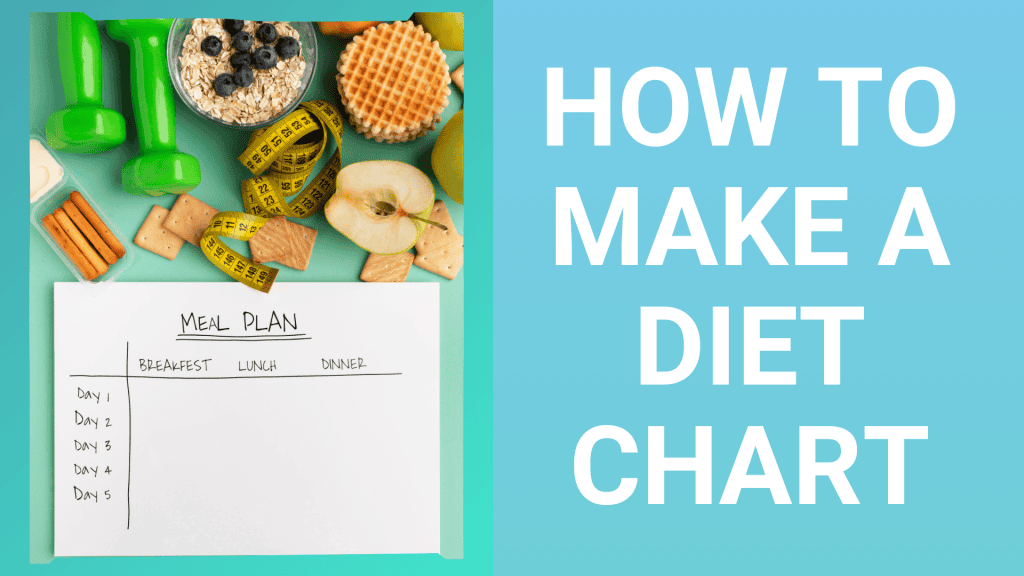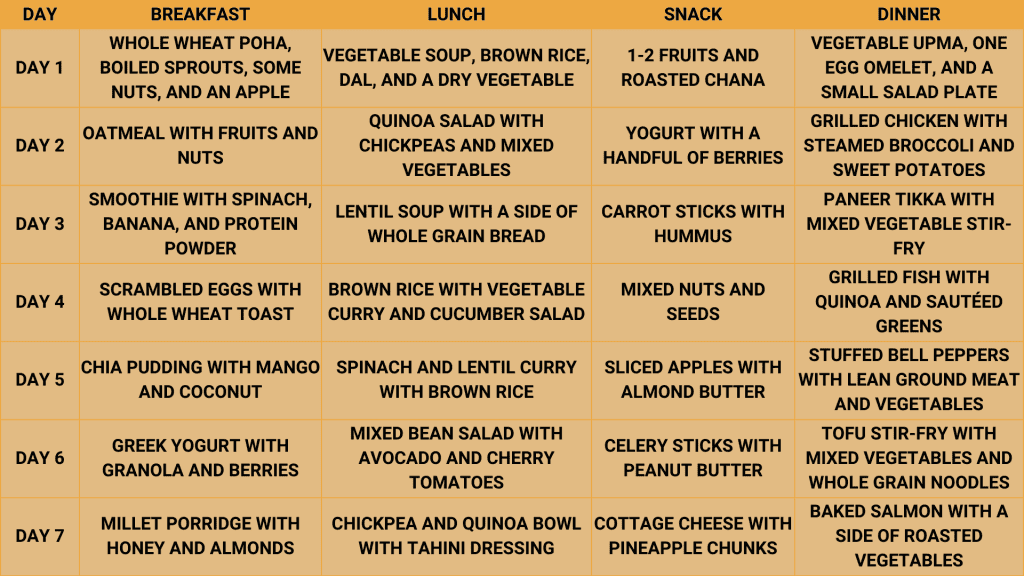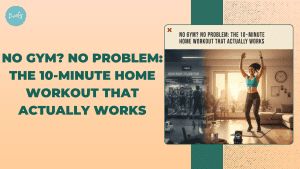In a diet chart, higher-fiber and starchy carbohydrate meals are crucial parts of the diet plan, making up just over a third of the food you eat. Potatoes, bread, rice, pasta, and cereals are some foods to choose from higher-fiber or wholegrain varieties. Whole wheat pasta, brown rice, or potatoes with their skins on are great matches for a diet chart. These options provide long-lasting energy, support digestive health, and help maintain a healthy weight. How to make a diet plan that fits the requirements of your body has always been a challenging and common question for dieticians, who try their best to guide people. To make a diet plan, you need to know your dietary needs, set realistic goals, and eat healthy foods to maintain a balance of nutrition in your diet. Here’s a detailed guide on creating a diet plan that suits your lifestyle and health objectives.
Can I Create a Diet Chart for Weight Loss?
Yes, creating diet plans or charts customized for weight loss requires nutrient-dense foods that provide satiety while being low in calories. By balancing macronutrients, adding a variety of fruits and vegetables, and ensuring portion control, you can easily make a diet chart at home. Regular monitoring of basal metabolic rate and diet changes based on your progress can help maintain long-term success.
Now, let us see how to make a diet plan customized according to personal needs and what steps to follow to create a perfect diet chart, just like a Diet plan for students.
How to Create a Diet Chart for Weight Loss?
While creating a weight-loss diet chart, you must prioritize your caloric needs, select nutrient-rich foods, and plan a balanced diet chart. Here are some essential steps to guide you while creating diet plans:
Step 1: Avoid Calorie-Counting Diet Plans
Calorie counting means setting a daily calorie goal and tracking everything you eat to stay within that limit. It sounds simple, but maintaining and following can be very difficult.
- Variety in Food Choices: Different foods have different calorie counts, making it easier to track everything with little effort.
- Cheat Days: Having cheat days can undo your progress during the week.
- Encouragement of Undereating: Trying to stick to calorie goals can lead to eating too little, which is unhealthy in the long run.
Instead of calories, focus on getting the proper nutrients like proteins, carbs, fats, vitamins, and minerals, which are more effective for weight loss and overall health. A study found that a person who focuses on balanced nutrition lost 30% more weight in a year than those who counted calories and reported 40% higher satisfaction levels with their diet. This shift in focus can enlighten you and provide a more informed approach to your health and wellness journey.
Step 2: Calculate Your Macros
Macronutrients are the primary nutrients your body needs in large amounts for energy and function. They include:
- Carbohydrates: Provide energy for muscles with the help of complex sugar chains.
- Fats: Store energy and are essential for hormones and brain function.
- Proteins: Build and repair tissues and provide lasting energy.
A balanced diet typically consists of 35% healthy fats, 40% protein, and 25% carbohydrates. You can use online calculators like the BMR calculator to find the correct ratios for your needs. A study showed that people who balanced their macronutrient intake had a 20% increase in muscle mass and a 15% decrease in body fat over six months.
Examples of Foods and Their Macronutrient Content
- Chicken Breast (100g): 165 calories, 31g protein, 3.6g fat, 0g carbs.
- Quinoa (100g cooked): 120 calories, 4.1g protein, 1.9g fat, 21.3g carbs.
- Avocado (100g): 160 calories, 2g protein, 15g fat, 9g carbs.
- Greek Yogurt (100g): 59 calories, 10g protein, 0.4g fat, 3.6g carbs.
Health Benefits of Example Foods
- Chicken Breast: High in protein, great for muscle growth.
- Quinoa: Rich in fiber and essential amino acids, good for digestion.
- Avocado: Full of healthy fats and supports heart health.
- Greek Yogurt: High in protein and probiotics, it helps muscle growth and gut health.
Step 3: Find Foods That Fit
Having foods you enjoy makes it easier to stick to your diet, and trying fruits, vegetables, and grains to keep things exciting and nutritious with high macronutrient content helps you decide on portion sizes and balance your diet. The research found that people who included healthy and light foods in their diets were 30% more likely to stick to their plans than those who followed stricter diets.
Examples of Foods with Nutritional Value and Health Benefits
- Spinach (100g) has 23 calories, 2.9g protein, 0.4g fat, and 3.6g carbs. It is high in iron and vitamins and supports immune function.
- Salmon (100g) has 208 calories, 20g protein, 13g fat, and 0g carbs. Rich in omega-3 fatty acids, it supports heart health.
- Sweet Potatoes (100g) have 86 calories, 1.6g protein, 0.1g fat, and 20 g carbohydrates. They are high in fiber and vitamins and are good for eye health.
- Almonds (28g) contain 161 calories, 6g protein, 14g fat, and 6g carbs. Rich in healthy fats and fiber, they support heart health.
Step 4: Stock Up on Recipes
Find recipes that match your tastes and dietary needs and adjust them to fit your preferences. For example, you can find zero calorie foods versions of baked foods or homemade sauces. A study found that people who tried new recipes regularly were 25% more likely to meet their nutritional goals and had a 20% higher rate of sticking to their diet after a year. Here are some healthy easy to make recipes:
1. Grilled Chicken Salad:
- Ingredients: 150g grilled chicken breast, 100g mixed greens, 50g cherry tomatoes, 30g cucumber, 20g feta cheese, 10ml olive oil, lemon juice, salt, and pepper.
- Nutritional Content: 340 calories, 35g protein, 18g fat, 8g carbs.
- Health Benefits: High in protein and vitamins, supports muscle growth and health.
2. Quinoa and Vegetable Stir-Fry:
- Ingredients: 100g cooked quinoa, 50g bell peppers, 50g broccoli, 50g carrots, 30g onions, 10 ml soy sauce, 5 ml sesame oil.
- Nutritional Content: 280 calories, 8g protein, 10g fat, 35g carbs.
- Health Benefits: High in fiber and vitamins, good for digestion and immune function.
3. Baked Salmon with Asparagus:
- Ingredients: 150g salmon fillet, 100g asparagus, 10ml olive oil, garlic, salt, and pepper.
- Nutritional Content: 350 calories, 30g protein, 20g fat, 5g carbs.
- Health Benefits: Rich in omega-3 fatty acids and vitamins, it supports heart health.
Step 5: Set an Eating Schedule
Meal timings affect metabolism and body energy levels, and having a meal every 3 hours can prevent overeating and keep energy levels steady. A study found that people who followed a consistent meal schedule, eating every 3 hours, had a 28% reduction in hunger levels and a 22% increase in energy levels. Also, those with high-protein breakfasts had 20% more fat loss than those who skipped breakfast or ate low-protein meals. Consult a doctor for a personalized diet chart if you have conditions like diabetes that affect how your body processes food.
- Filling Dinner: Reduces late-night snacking.
- High-Protein Breakfast: Boosts energy levels early in the day.
- Consistency: Stick to your meal schedule for the best results.
1. Male Eating Schedule (2500 Calorie diet plan/day)
- Breakfast (8 AM): 500 calories – High-protein breakfast (e.g., Greek yogurt with berries and nuts).
- Mid-Morning Snack (11 AM): 250 calories – Almonds and a piece of fruit.
- Lunch (1 PM): 700 calories – Grilled chicken salad with quinoa.
- Afternoon Snack (4 PM): 250 calories – Hummus with vegetable sticks.
- Dinner (7 PM): 700 calories – Baked salmon with asparagus and sweet potatoes.
- Evening Snack (9 PM): 100 calories – A slight protein shake.
2. Female Eating Schedule (2000 calorie diet plan/day)
- Breakfast (8 AM): 400 calories – High-protein breakfast (e.g., Greek yogurt with berries and nuts).
- Mid-Morning Snack (11 AM): 200 calories – Almonds and a piece of fruit.
- Lunch (1 PM): 600 calories – Grilled chicken salad with quinoa.
- Afternoon Snack (4 PM): 200 calories – Hummus with vegetable sticks.
- Dinner (7 PM): 500 calories – Baked salmon with asparagus and sweet potatoes.
- Evening Snack (9 PM): 100 calories – A small protein shake.
Step 6: Track, Analyze, and Adjust
Keeping a food diary helps you see your eating habits and adjust your diet to stay on track with your weight loss goals.
- Daily Caloric Intake: Make sure you meet your caloric needs.
- Macronutrient Ratios: Track the balance of carbs, proteins, and fats.
- Nutrient Intake: Monitor your vitamin and mineral intake.
- Physical Activity: Log your exercise and daily activity levels.
- Weight and Measurements: Record weekly to track progress.
The steps noted clearly explain how to make a diet plan that perfectly fits your needs. Now, let’s move on to factors to consider while creating diet plans.
Factors to Consider While Creating a Diet Chart
When you are creating diet plans, it’s important to think about several key factors to ensure they meet your nutritional needs and help you reach your health goals. Let’s break down the most important ones.
- Caloric Requirements: Calculating calorie needs is based on metabolic rate
- Nutrient Balance: Balance of macronutrients and micronutrients.
- Food Preferences and Allergies: Consider food intolerances or allergies.
- Lifestyle and Schedule: Plan meals that fit your daily routine.
- Hydration: Water intake is required as part of your diet plan.
1. Caloric Requirements
This means the number of calories your body needs each day and calculating this to make an effective diet chart you first need to understand your Basal Metabolic Rate (BMR), which is the number of calories your body needs just to stay alive if you are at rest all day. Then, you add the calories you burn through physical activity. For example, an average woman who doesn’t move much needs about 1,800-2,000 calories daily, but if she’s active, she might need 2,200-2,400 calories.
2. Nutrient Balance
This means making sure your diet has the right mix of macronutrients (carbs, proteins, fats) and micronutrients (vitamins and minerals). A balanced diet gives your body the energy and nutrients it needs to function well, and it should have 45-65% carbohydrates, 10-35% protein, and 20-35% fat. So, eating a variety of fruits, vegetables, whole grains, lean proteins, and healthy fats helps you get this balance.
3. Food Preferences and Allergies
Consider foods you like or dislike and any intolerances or allergies you have to ensure you stick to the diet and avoid any health issues. For example, if you are lactose intolerant, you should avoid dairy products but include other calcium and vitamin D sources, like plant-based milk and leafy greens. Personalizing your diet to fit your tastes and needs can make it much more effective and easier to follow.
4. Lifestyle and Schedule
Your diet plan needs to fit into your daily routine and be practical, which means planning meals and snacks that are easy to prepare and eat, especially if you have a busy lifestyle. For instance, if mornings are hectic for you, planning quick and healthy breakfast options like overnight oats or smoothies can make it easier to stick to your diet.
5. Hydration
Drinking enough water is crucial for your overall health and should be an essential part of your diet plan. Proper hydration impacts everything from energy levels to digestion and nutrient absorption. Men should drink about 3.7 litres of water daily, and women should drink about 2.7 litres, including fluids from all beverages and food. Therefore, eating water-rich foods like fruits and vegetables also helps keep you hydrated.
Addressing these factors can ensure that your diet plan is suitable for your individual needs and supports your health goals. Let’s jump onto a sample chart of how to make a diet plan.
Sample 7 Days Diet Chart for Weight Loss
Here is a sample 7-day diet chart designed for weight loss, focusing on Indian cuisine:
Day 1:
- Breakfast: Whole wheat poha, boiled sprouts, some nuts, and an apple.
- Lunch: Vegetable soup, brown rice, dal, and a dry vegetable.
- Snack: 1-2 fruits and roasted chana.
- Dinner: Vegetable upma, one egg omelette, and a small salad plate.
Day2:
- Breakfast: Oatmeal with fruits and nuts.
- Lunch: Quinoa salad with chickpeas and mixed vegetables.
- Snack: Yogurt with a handful of berries.
- Dinner: Grilled chicken with steamed broccoli and sweet potatoes.
Day 3:
- Breakfast: Smoothie with spinach, banana, and protein powder.
- Lunch: Lentil soup with a side of whole grain bread.
- Snack: Carrot sticks with hummus.
- Dinner: Paneer tikka with mixed vegetable stir-fry.
Day4:
- Breakfast: Scrambled eggs with whole wheat toast.
- Lunch: Brown rice with vegetable curry and cucumber salad.
- Snack: Mixed nuts and seeds.
- Dinner: Grilled fish with quinoa and sautéed greens.
Day 5:
- Breakfast: Chia pudding with mango and coconut.
- Lunch: Spinach and lentil curry with brown rice.
- Snack: Sliced apples with almond butter.
- Dinner: Stuffed bell peppers with lean ground meat and vegetables.
Day6:
- Breakfast: Greek yogurt with granola and berries.
- Lunch: Mixed bean salad with avocado and cherry tomatoes.
- Snack: Celery sticks with peanut butter.
- Dinner: Tofu stir-fry with mixed vegetables and whole grain noodles.
Day 7:
- Breakfast: Millet porridge with honey and almonds.
- Lunch: Chickpea and quinoa bowl with tahini dressing.
- Snack: Cottage cheese with pineapple chunks.
- Dinner: Baked salmon with a side of roasted vegetables.
Expert Review on How to Make a Diet Chart
Dr Sakshi Gupta, a certified nutritionist and a doctor, tells us how to make a diet plan that requires a mindful approach while considering caloric needs, nutrient balance, and personal preferences. She says that it is important to plan nutritious, satisfying meals that fit your health goals, and following the steps mentioned in this guide and making changes based on your progress, you can develop an effective diet chart that supports a healthy lifestyle and weight management.
References
“Eat Right – Healthy Eating Plan.” n.d. NHLBI. Accessed July 15, 2024. https://www.nhlbi.nih.gov/health/educational/lose_wt/eat/calories.htm.
Mithbavkar, Shraddha. 2023. “(PDF) DIET PLANNER USING DEEP LEARNING.” ResearchGate. https://www.researchgate.net/publication/370472642_DIET_PLANNER_USING_DEEP_LEARNING.
Ward, Elizabeth M. 2009. “Personalize Your Diet Plan: How to Design a Diet around Your Eating Habits.” WebMD. https://www.webmd.com/diet/features/how-to-design-your-own-diet.
FAQs
1. How do you calculate a diet chart?
To calculate a diet chart, use the following formulas:
- Males: Calories per day = 10x(weight in kg) + 6.25x(height in cm) – 5x(age) + 5.
- Females: Calories per day = 10x(weight in kg) + 6.25x(height in cm) – 5x(age) – 161.
2. How do I plan my daily diet?
A healthy diet emphasizes vegetables, fruits, whole grains, and fat-free or low-fat dairy products. It includes lean meats, poultry, fish, beans, eggs, and nuts while limiting saturated and trans fats, sodium, and added sugars.










